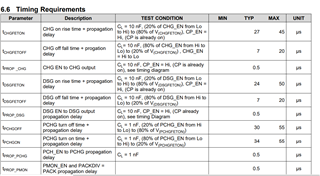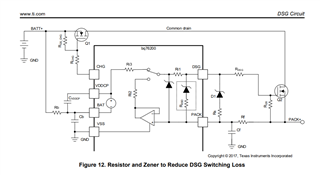Hi team,
Please help confirm the current drive capability of the MOSFET drive pin of BQ76200, including instantaneous drive capability and steady-state drive capability.
According to the datasheet, if i use the dv/dt*C=I, the output current from the DSG would be 4mA. Am i right?

I read the bq76200 Beyond the Simple Application Schematic, bq76200 would use the energy stored in Cvddcp,(which is charged by internal charge pump) to drive the gate of mos via DSG or CHG. Meanwhile, the internal charge pump still charging the gate of mos. Am i right? Further more, the quick and larger charging current from the cap would be called as instantaneous driving capability. And the charging current from the internal charging pump would be called as steady-state drive capability.
Q1.could you please tell me how to calculate the charging current from the cap?
Q2.And how much current could the internal charging pump output?

yours
nan


